Like most years, the landscape department takes advantage of the upcoming holiday break to do some tree removals. Not that we are doing anything under the cover of darkness-it’s more like we don’t want to break the solitude of campus with the cacaphony of chainsaws and tree chippers, not to mention the lack of stress we have when not having to do hazardous work with pedestrians walking around us.
Like last year, we’re working off of a hazardous tree list we’ve kept for several years now. Each year, the hazardous trees are inspected in the early fall, the best time to observe stress in the plant. We’re getting toward the end of the list of hazards that must be removed, as this year we’ve selected 6 trees that for reasons described below must be removed.
Actually, 7 trees, but one is sad and important enough to warrant it’s own post later in the week.
The first tree on the list is a big one, a Norway maple north of Starr/Axinn. Like I’ve written previously, this tree is held together by a web of cables up in the crown, two complete systems. The first set is a group of three cables holding the main scaffolds together, and the second set is a complete ring around the canopy. Like we’ve seen in the Black Willow that failed by Battell, failure of one of these limbs can compromise the rest of the cable system, and lead to total failure. For this reason cable systems should be inspected yearly, preferably whilst up in the crown of the tree.
This tree has been declining in health for the past several years.. Notice the greatly thinning canopy in the following pictures, with the interval between last year and this being by far the greatest loss.
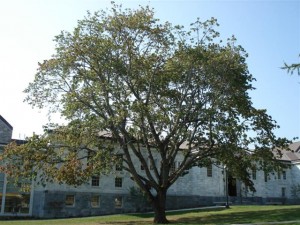
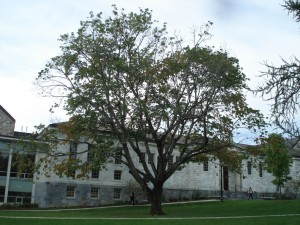
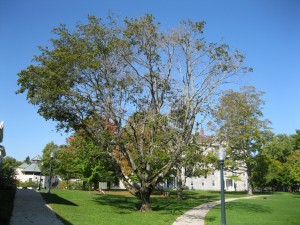
The cabling systems were originally installed to protect against failure in the main trunk. Norway maples, though, have a life span, one that is quite a bit shorter than I’d thought, and this tree has reached the end of it’s life. Over 75% of the crown was dead wood, with hollow scaffold branches held up only by cable. Most worrisome was the appearance of several types of fungi, indicating rotten wood both in the trunk and in the root system. While I hate to see such a large tree go, we can’t risk failure in an area so heavily trafficked.
The next tree on the list is another large one, a Silver maple by the Davis Family Library.
Silver maples are poor compartmentalizers, meaning any wounds they suffer sit and rot, further decay going up the stem and into the trunk. This tree has a major defect at the attachment of the main scaffolds, and hollow limbs on two of them. This tree had a hanging branch several years ago, and I climbed up there on rope to remove it. After ascending, I noticed the branch I was tied into was completely hollow, an empty tube the length of the branch. I didn’t stay up long.
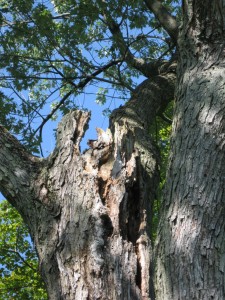 After any major windstorm I would always look towards this tree on my drive into work to see if it was still standing. The crack shown above has opened up in the last year.
After any major windstorm I would always look towards this tree on my drive into work to see if it was still standing. The crack shown above has opened up in the last year.
Another Norway maple in need of removal is next to Centeno, another Norway at the end of it’s life. This tree, like the other, has poor scaffold attachments at the base, and suffers from major cavities with rot. The crown has also suffered major decline in the preceding year, losing much of it’s foliage.
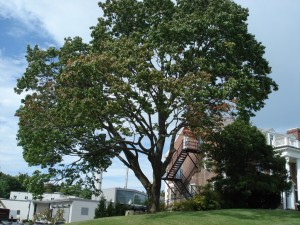
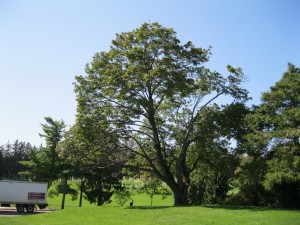
The rot in the trunk holds water, and is actually deep, over 1 foot. Note how, typical of Norways, much of the leaf surface is on the ends of the branch, and therefore much of the weight is as well. This raises a red flag, as high wind events cantilever the branch, with the foliage acting like a sail.
At the top of the stairs leading to the east side of Gifford is a Black Cherry tree, leaning towards the stairs and a nearby light pole.
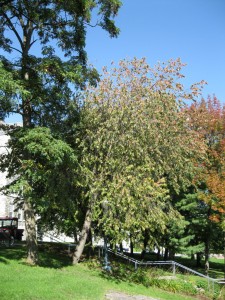 Lean in a tree towards a target is always troublesome, or at the least worthy of a second, closer look. This tree suffers from a cavity at the root flare in the direction of the lean, indicating a weakened or even missing root system in the potential failure direction.
Lean in a tree towards a target is always troublesome, or at the least worthy of a second, closer look. This tree suffers from a cavity at the root flare in the direction of the lean, indicating a weakened or even missing root system in the potential failure direction.
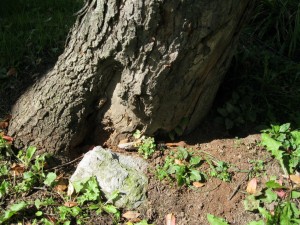 The last two trees on this removal list are both Sugar maples, which, given the percentage of Sugars on campus, is hardly surprising. The first tree doesn’t really have an obvious cause of death, but is nearly dead nonetheless. It’s located up at the tailgate area, near Route 30.
The last two trees on this removal list are both Sugar maples, which, given the percentage of Sugars on campus, is hardly surprising. The first tree doesn’t really have an obvious cause of death, but is nearly dead nonetheless. It’s located up at the tailgate area, near Route 30.

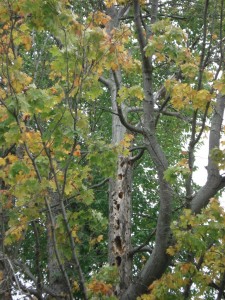 The final sugar to remove is located up by Hepburn, and to be honest I didn’t really want to see this one go. In fact, it probably should have been removed several years ago, when its defect was first noticed. Students in my winter term class will recognize it, and the tree is prominent in all of my tree tours. Rarely do you see such a concrete example of girdling roots causing an untimely death.
The final sugar to remove is located up by Hepburn, and to be honest I didn’t really want to see this one go. In fact, it probably should have been removed several years ago, when its defect was first noticed. Students in my winter term class will recognize it, and the tree is prominent in all of my tree tours. Rarely do you see such a concrete example of girdling roots causing an untimely death.
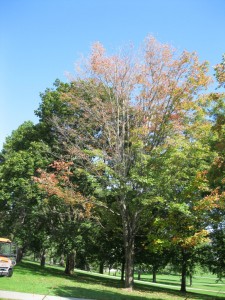 Nobody ever said trees were terribly intellegent. This tree grew several roots that wrapped around the root flare, so as they grew the tree was slowly strangling itself.
Nobody ever said trees were terribly intellegent. This tree grew several roots that wrapped around the root flare, so as they grew the tree was slowly strangling itself.
Water couldn’t go up the trunk, nor nutrients down. It showed all the classic symptoms of root girdling over the last several years. First the top started to die back, as the very upper reaches of the tree starved. Next the side of the tree with the girdling died back, followed by major sections of the trunk. Finally the entire tree itself starved as it tried to reprioritize, but without sufficent water and nutrient flow just couldn’t retrench to live out its final days the way many mature trees do.
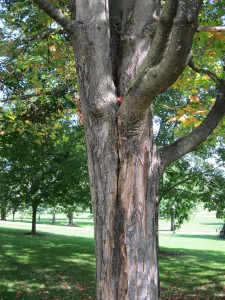 I’m compiling our Tree Karma score for this year as part of our Tree Campus re-application, but am fairly confident we’ve planted many, many more trees than we’ve removed, even with all the freak storms this summer. Feel free to contact me with further questions or concerns you may have.
I’m compiling our Tree Karma score for this year as part of our Tree Campus re-application, but am fairly confident we’ve planted many, many more trees than we’ve removed, even with all the freak storms this summer. Feel free to contact me with further questions or concerns you may have.

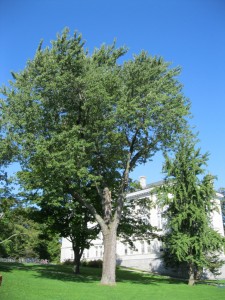
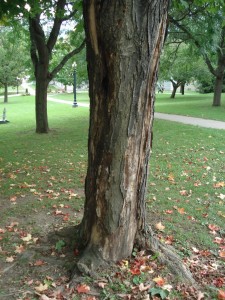
Any idea “why” a tree would grow roots around its root flare? Is there something about the nutrition in the soil or other environmental conditions (rocks?) that would cause such tortured root growth?
Good question!
I’ve never seen a girdling root in the forest, but that isn’t to say it can’t happen. Most girdling roots, however, are probably human faults, the way they may have been grown at a nursery, or the way they may have been transplanted. Trees may not be super intelligent, but they’ve probably figured out how to grow by now. Leave it up to us to mess that up…
I remember landscaping down in Connecticut and seeing an entire yard of Norway maples all about the same age, and all dying young. Most had girdling roots, and our suspicion was that they were transplanted bare root, and the person planting the trees dug small holes, and ‘spun’ the tree around in a circle to get the tree to fit in the hole.
You’ll also see girdling roots in pot bound plants, and should carefully prune those away when planting.